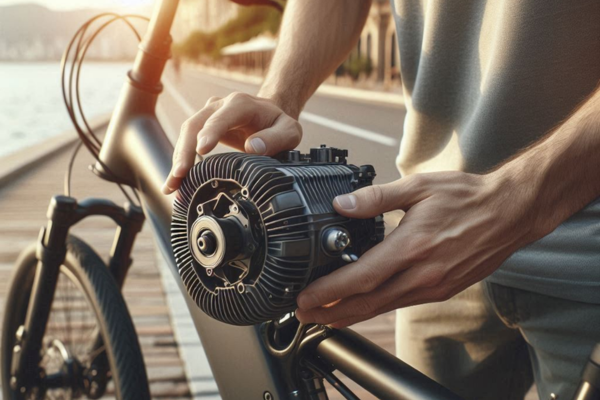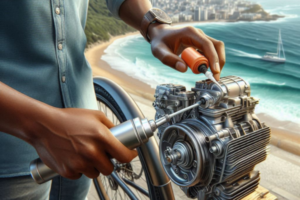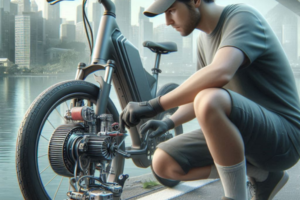💧 Why Humidity Is the Silent Enemy of E-Bike Motors
When investing in an electric bicycle, the motor is not just another component—it’s the core of performance and longevity. In humid environments, especially coastal regions, this essential part faces a persistent and invisible threat: moisture. Unlike obvious damage like a flat tire or a cracked screen, humidity sneaks in quietly. It corrodes, degrades, and eventually cripples even the best-engineered systems if left unaddressed.
Humidity doesn’t just affect aesthetics. It directly impacts internal circuitry, bearings, and connectors—components critical for smooth acceleration and consistent power. The danger increases in environments with daily exposure to salty air, tropical heat, and condensation. These conditions amplify corrosion exponentially.
For many e-bike owners, their first warning comes too late: erratic motor behavior, loss of power, overheating, or expensive diagnostic results. And yet, these issues are completely avoidable with proactive care and smart sealing. Understanding the long-term effects of humidity on your motor is the first step in protecting your investment—and ensuring years of reliable riding. 🚴♀️
🧪 What Happens When Moisture Enters the Motor?
When water vapor finds its way inside the motor casing or connectors, several reactions begin to unfold:
- ⚠️ Corrosion: Moisture reacts with metal parts, especially around connectors and screws, causing rust and weakening structure.
- ⚡ Short circuits: Water can bridge contacts on the circuit board, damaging sensors and triggering faults.
- 🔥 Overheating: Humidity interferes with thermal dissipation, leading to temperature spikes during rides.
- 🔋 Battery stress: Humidity can seep into the battery compartment, causing instability or false readings.
Even if the motor has factory-grade waterproofing, prolonged exposure wears down protective barriers. That’s why periodic maintenance and environmental adaptation are essential.
📊 Visual Comparison: Motor Wear in Dry vs. Humid Climates
| Component | Dry Climate (2 Years) | Humid Climate (2 Years) |
|---|---|---|
| Connectors | Minimal wear | Corrosion buildup |
| PCB Circuitry | Clean and dry | Oxidation and possible shorts |
| Motor Bearings | Stable lubrication | Contaminated by condensation |
🌱 Why Prevention Pays Off
Motor replacements can cost hundreds of dollars. Downtime due to corrosion damage is frustrating, and warranty coverage often doesn’t extend to environmental neglect. Yet with a few consistent habits—proper sealing, inspections, and smart storage—you can avoid 90% of corrosion-related motor issues.
💡 Inspiration: Every drop of moisture you keep out is a mile of freedom you gain. Prevention isn’t optional—it’s an investment in your ride.
🛡️ Long-Term Protection Strategies for Humid Environments
Once you understand how humidity affects your e-bike motor, the next step is to build a long-term protection plan. This isn’t about expensive upgrades—it’s about smart habits, accessible tools, and consistency. With the right sealing, coating, and inspection routine, you can defend your motor from the corrosive nature of coastal and tropical air.
Let’s break down what real-world protection looks like. A one-time application of waterproof spray won’t cut it. Protection is a continuous investment. Fortunately, maintaining a protective cycle is neither complicated nor expensive when you know what to prioritize.
🔍 Key Protection Actions and Frequency
- 🔄 Reapply dielectric grease: Every 1–2 months on all connectors and charging ports.
- 🧴 Use corrosion inhibitors: Every 3 months around motor housing and exposed metal parts.
- 🧼 Clean and dry your motor casing: Weekly or after every wet ride.
- 🔦 Inspect gaskets and seals: Every 2 months to detect cracking or loosening.
📦 Table: Recommended Protection Products
| Product Type | Purpose | Suggested Use |
|---|---|---|
| Dielectric Grease | Seal electrical connectors | Every 6–8 weeks |
| Silicone Spray | Coat motor casing externally | Every 2–3 months |
| Flexible Tape | Wrap around vulnerable cable exits | Replace as needed |
📦 Bonus Tip: Store It Right, Protect It Longer
One of the simplest, most overlooked strategies is **smart storage**. Don’t park your e-bike next to damp walls or on bare concrete. Elevate the bike, use a breathable cover, and ensure airflow around the motor zone. This alone can cut your exposure to ambient moisture by over 40%.
💡 Expert Tip: Treat your motor like a laptop. You wouldn’t leave your electronics near a leaking window—your e-bike deserves the same respect.
🔄 Visual Reminder: Coating Is Not a One-Time Fix
Many riders make the mistake of applying a sealant once and forgetting it. But like sunscreen or tire pressure, protection must be renewed. As time, heat, and vibration wear it down, the risk of water entry rises.
The best riders aren’t those with the newest bikes—but those who maintain theirs like they matter. With consistent care, your e-bike motor can remain as efficient as the day you bought it—no matter how salty the air.
💡 Inspiration: Long-term protection is quiet but powerful. It doesn’t just preserve your motor—it protects your lifestyle.
⚠️ Common Mistakes That Reduce Motor Life in Humid Climates
No matter how well-meaning, many e-bike owners unknowingly compromise their motor’s health through small but significant oversights. In dry climates, these mistakes may go unnoticed. But in humid environments, they accelerate wear, corrosion, and eventual failure. If you’ve experienced unexpected motor issues, chances are one or more of these missteps are the cause.
🧯 Most Frequent Mistakes Riders Make
- 🧴 Using harsh or inappropriate cleaning products: Many household cleaners contain chemicals that degrade seals and coatings over time.
- 🕳️ Neglecting small gaps: Cable exits, charging ports, and bolt areas are often ignored—but they’re moisture magnets.
- 🌧️ Storing the bike in damp or unventilated spaces: Moisture accumulates quietly when airflow is blocked, especially in garages or basements.
- 🔌 Failing to protect connectors: Unsealed connectors can become corroded internally, leading to shorts and erratic power delivery.
- 🛠️ Skipping inspections: If you wait until something “feels wrong,” it may already be too late to prevent damage.
📊 Table: Mistakes and Their Consequences
| Mistake | Immediate Impact | Long-Term Consequence |
|---|---|---|
| Using the wrong cleaner | Breaks down protective coatings | Seal failure and water entry |
| Ignoring vents and cable gaps | Moisture infiltration | Internal corrosion |
| Poor storage habits | High humidity exposure | Faster deterioration of electronics |
| Unprotected connectors | Erratic electrical performance | Premature component failure |
📋 Checklist: Are You Making These Mistakes?
- ☐ I use only electronics-safe cleaners on my motor
- ☐ I inspect cable exits and motor vents monthly
- ☐ I store my e-bike in a ventilated, dry location
- ☐ I apply dielectric grease to connectors regularly
- ☐ I don’t wait for visible issues to start maintenance
🚨 Real-World Tip: If your bike’s motor area feels warm or smells musty after a ride, it’s a sign that moisture may already be trapped inside. Act immediately before deeper damage sets in.
Mistakes happen—even to the most dedicated riders. What matters most is learning from them and adjusting your care strategy moving forward. If you’re reading this, you’re already on the right path. Every adjustment you make now will reward you with a smoother ride, longer motor life, and fewer repair costs down the road.
💡 Reflection: Don’t wait for a failure to value prevention. What you protect today will carry you tomorrow.
🧰 Create a Smart Maintenance Routine to Fight Humidity
A well-protected motor isn’t the result of luck or expensive upgrades—it’s the product of a thoughtful, consistent maintenance routine. Think of it as your weekly conversation with your bike: a way to check in, reset, and protect your long-term investment. In humid environments, even a minor habit done regularly can mean the difference between a healthy motor and one damaged by corrosion.
Maintenance doesn’t have to be time-consuming or complicated. You just need a system. Here’s how to build one that’s simple, realistic, and effective for coastal or tropical areas where moisture and salt are persistent intruders. 🌬️💦
🧽 Weekly Motor Care Checklist
- 🧼 Wipe down the motor casing: Use a microfiber cloth to remove salt spray or moisture.
- 🔍 Inspect cable exits: Look for residue, cracking seals, or signs of corrosion near the joints.
- 🧴 Apply silicone or PTFE spray: Reinforce the outer protection layer every 2–3 weeks.
- ⚙️ Check connector tightness: Gently tug connectors to ensure they haven’t loosened with vibrations.
📅 Maintenance Frequency Guide
| Task | Recommended Frequency | Why It Matters |
|---|---|---|
| Wipe down motor casing | Weekly | Removes salt and condensation |
| Inspect seals/connectors | Biweekly | Detects early signs of corrosion |
| Reapply spray coating | Every 3 weeks | Renews external protection |
| Grease electrical contacts | Every 2 months | Prevents shorts and internal rust |
💡 Smart Habit: Sync your maintenance with something you already do—like charging your bike on Sundays or wiping your helmet. Habit stacking makes it easier to be consistent.
🌿 Visual Reminder: Maintenance Is Like Watering a Plant
You wouldn’t wait for a plant to wilt before giving it water. Likewise, don’t wait for rust to form before giving your motor care. The more consistent your actions, the healthier and more resilient your system becomes. Humidity is silent—but so is great maintenance.
💡 Reflection: Maintenance is more than prevention—it’s a quiet act of care that builds confidence in every ride.
💬 Frequently Asked Questions (FAQs) on Long-Term Motor Protection
Is factory waterproofing enough for coastal conditions?
Not entirely. While most e-bike motors come with some degree of waterproofing, factory seals are often not designed for constant exposure to humidity and salt. Reinforcing them with external coatings and routine care ensures durability and prevents corrosion from creeping in over time.
What’s the safest cleaning method for my motor in a humid city?
Avoid high-pressure water. Use a damp microfiber cloth and electronics-safe cleaner. Dry the motor thoroughly with a soft cloth and allow airflow before storage. Never spray directly into connectors or vents.
How can I tell if humidity is already damaging my motor?
Watch for early signs: subtle rust on bolts, sticky or delayed acceleration, unusual heat around the motor after riding, or difficulty charging. These could indicate corrosion, seal failure, or moisture in key components.
Do I need professional tools to maintain motor protection?
No. Basic tools like dielectric grease, silicone spray, a flashlight, microfiber cloths, and isopropyl alcohol are usually sufficient. What matters more is frequency and consistency—not expensive gear.
💖 Final Thoughts: Your Motor, Your Journey, Your Care
Choosing an electric bicycle is more than a practical decision—it’s a declaration of freedom, sustainability, and independence. And just like any long-term relationship, it requires care, attention, and intention to thrive—especially when the environment is less than gentle.
By committing to preventive care, sealing routines, and smart maintenance, you’re not just protecting a piece of machinery. You’re safeguarding your lifestyle, your mobility, and your ability to keep moving forward—rain, shine, or salty breeze.
Remember: corrosion is slow but relentless. But so is protection—when practiced consistently. Your motor deserves the same dedication you bring to every ride.
💡 Inspiration: Every ride begins with trust—trust that your bike will take you where you want to go. And that trust begins with care.
🌎 Join the Conversation: How Do You Protect Your Ride?
Do you ride in a coastal or humid city? Have you developed your own system to keep your motor safe from moisture? Or did you learn a valuable lesson the hard way? Sharing your experience could inspire others—and prevent costly mistakes.
Let’s connect: 💬 What has worked for you? 🧪 What product do you swear by? 🔁 What habit has made the biggest difference in motor health?
Leave a comment and be part of a growing community of smart, conscious riders who care not just about performance—but about preservation. Because riding far starts with protecting what gets you there. 💙🚴♀️



